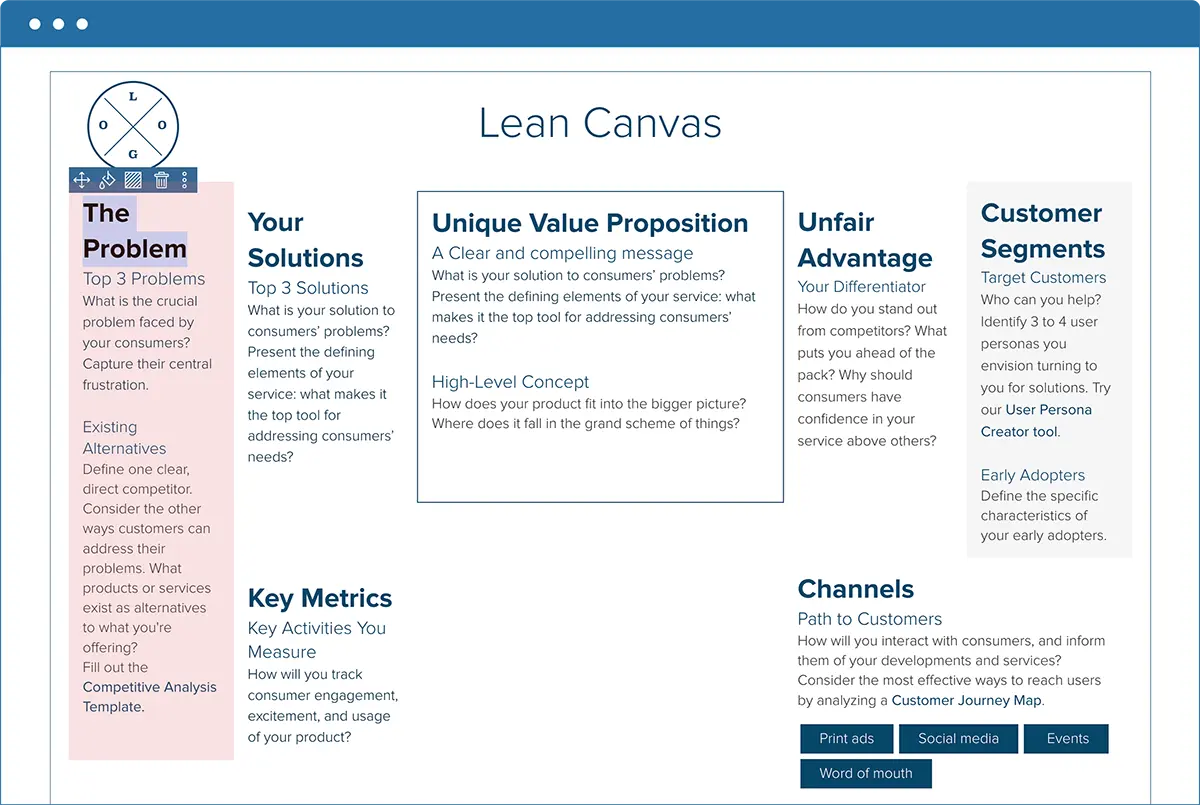How to populate a lean canvas?
In this section we study the process of filling out a Lean Canvas, a succinct business plan tool.
Understanding the Lean Canvas
The Lean Canvas is a concise business plan that emphasizes both the market and product sides of a venture. Unlike traditional plans that might heavily focus on product development, the Lean Canvas forces an equal emphasis on the customer-facing aspects.
The canvas is typically divided into sections, and there's a specific order recommended for filling it out.
How to Populate the Lean Canvas (Order of Filling)
-
Customer Segments:
- Identify your target customer: Be as specific as possible. Even for a seemingly universal product, identify the early adopters. For example, for millet-based cookies, instead of "everyone," specify "young fitness enthusiasts" or "diabetics/pre-diabetics."
- Distinguish between customer and user: The customer is the one who pays (e.g., parents buying toys for toddlers, schools buying educational products). The user is the one who uses the product (e.g., toddlers, students). Both need to be considered, as user experience impacts customer preference and purchase decisions.
-
Problems:
- List top 2-3 problems: For your identified customer segment, articulate the top two or three most pressing problems or needs your product/service aims to solve. Avoid listing too many problems, as it can indicate a lack of focus.
- Frame problems from the customer's perspective: For millet cookies for diabetics, the problem might be "lack of suitable low-glycemic index snacking options."
- Identify existing alternatives: In the same box, note how customers currently solve these problems, even if it's not through a direct competitor's product but an alternative mechanism.
-
Solution:
- Clearly articulate how your product or service intends to solve the problems identified for the customer. For the millet cookies, the solution would be "nutritious, satiating, low-glycemic cookies."
-
Unique Value Proposition (UVP):
- This central element bridges the market and product sides.
- Definition: A single, clear, compelling message explaining why customers should care about your product/service. It highlights what makes your offering unique, valuable, and different from alternatives.
- Components: A good UVP often incorporates elements of both the problem being solved and the solution offered, framed in a compelling way. For the millet cookies, a UVP could be "Healthy and hearty cookies that keep you going through the day."
- Resource: Tools like the Value Proposition Canvas can help in fine-tuning your UVP.
-
Channels:
- Pathways to customers: Define how you will reach and acquire your target customers. This could be physical (e.g., clinics for diabetics) or digital (e.g., Instagram for younger demographics, LinkedIn for professionals).
- Targeted approach: The more precisely you define your customer segment, the more effectively you can select and focus on specific channels, optimizing marketing efforts and budget.
-
Revenue Streams & Cost Structure:
- Revenue Streams: What will you charge for your product/service (e.g., price per unit, subscription models)? At the initial stage, it's okay to have rough estimates; these will evolve.
- Cost Structure: What are the main costs involved in running operations, delivering the product/service, customer acquisition, distribution, etc.? Again, initial estimates are acceptable. Don't overthink this in the very beginning, as the primary focus is problem-solution fit.
-
Key Metrics:
- Activities to measure: List the crucial activities and outcomes you will track to gauge the venture's progress.
-
Stage-dependent: Metrics will change as the venture evolves.
- Early stage: Number of customer interviews, percentage of customers showing interest, feasibility metrics.
- Later stage (with product/website/app): Website traffic, user registrations, purchase conversion rates, repeat customers, app downloads, daily/weekly usage, retention rates.
-
Unfair Advantage:
- Competitive edge: What unique advantage do you possess that others cannot easily copy or acquire?
- Examples: Patents, strong partnerships, robust supply chains, superior distribution networks, or exceptionally user-friendly technology/design.
- Initial Absence: It's common not to have a clear unfair advantage at the very beginning. This is often something built over time. Don't stress if this box is initially empty.
- Caution: Avoid claiming "first-mover advantage" without thorough validation, as many ideas are simultaneously being explored by others, and being first doesn't guarantee success.
Lean Canvas as a Tool:
- The Lean Canvas is a crisp, intuitive tool to capture your business idea on a single sheet of paper.
- The first version can typically be completed in 15-20 minutes.
- It serves as a starting point for clarifying your understanding of the customer's problem, your unique solution, and your value proposition.
- Snapshot in Time: The Lean Canvas represents the business as it stands today, not a future goal. It's a dynamic document that should be updated as you learn and iterate.
Entrepreneurs are encouraged to start drawing up a Lean Canvas for their ideas to clarify their thinking and move their venture forward.

